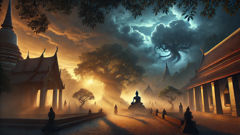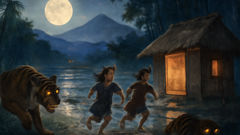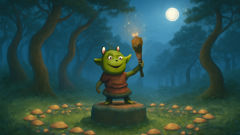Introduction
In the far northwestern corner of South Africa, where sunbeams bake the ochre earth and shadows stretch long over the bouldered plains, a landscape of stark beauty hides secrets far older than any road or settlement. The Richtersveld, with its jagged peaks and winding Orange River, whispers stories in the wind—tales carried by San hunters, echoed by Nama shepherds, and etched in the hearts of those who know the land’s ancient pulse. But none is more enigmatic than the legend of the Grootslang: a creature forged in the world’s earliest dawn, when the gods themselves shaped animals and stones with reckless abandon. They say that beneath the copper-skied valleys lies a cavern so deep that no human has ever reached its end—a place glimmering with untold wealth, guarded by a being as old as time. The Grootslang is no mere serpent; it’s a primordial beast, its body as long as a river and its head crowned with ivory tusks and leathery ears. In its eyes flicker the glint of diamonds, and its voice is said to rumble like distant thunder. For centuries, travelers and fortune-seekers have vanished into the mountain’s heart, drawn by rumors of treasure. Only a rare few have stumbled back, changed forever by what they saw. Some call the tale a warning against greed; others see it as a riddle about wisdom and respect for the wild. This is the story of the Grootslang—of its creation, its hidden lair, and those who dared to bargain with the guardian of South Africa’s deepest secrets.
The Birth of the Grootslang
Long before the first people set foot in the Richtersveld, the land was nothing but rock and wind—a raw, unfinished world sculpted by divine hands. The gods, in their enthusiasm and inexperience, shaped creatures for every corner of creation. Some they made small and quick, others mighty and ponderous, some gentle, some fierce. But one day, in a moment of oversight or perhaps wild inspiration, they created something far greater than they intended.

From clay and starlight, the gods molded a being of unmatched power and cunning. Its body was that of an immense serpent—scales hard as granite, muscles like coiled rivers. But where a head should have been, they placed the noble visage of an elephant: wise, ancient eyes, leathery ears, and long, curved tusks. The creature’s trunk was prehensile and sensitive, able to sense the faintest tremor in the earth. Thus the Grootslang was born, straddling the boundary between two worlds: earth and water, beast and spirit.
The gods soon realized their error. No single creature should possess so much strength and wisdom combined; such a beast would be too formidable for any world to contain. They sought to undo their creation, to separate the serpent from the elephant, and let each roam the savanna in its own right. But the Grootslang was clever and proud. Sensing their intentions, it vanished into the earth before the gods could intervene.
Legends say the Grootslang burrowed deep into the heart of the mountains, carving out a labyrinthine cave beneath what would one day be called the Richtersveld. There, it claimed dominion over the darkness, gathering all that glittered: diamonds, emeralds, rubies, and gold. It became the eternal guardian of the cave—a being neither fully of this world nor the next, a living riddle that echoed the wildness of creation itself.
Over generations, people heard whispers of the Grootslang’s lair. Some called it the Wonder Hole, others the Bottomless Pit. It was said that the creature’s treasure was beyond counting, but none who sought it returned unchanged. Some were never seen again; others came back broken or silent, their eyes haunted by visions no words could capture. The Grootslang itself rarely emerged, except on moonless nights when the wind howled and the river ran thick and red after a storm. On those occasions, its immense form could be glimpsed by torchlight—an ancient sentinel whose gaze weighed every trespasser’s heart.
The First Encounters: Greed and Awe
Centuries passed, and humans came to the Richtersveld, drawn by the promise of grazing land and the river’s cool embrace. The Nama and San peoples lived in harmony with the landscape, wary of its dangers but respectful of its gifts. They told stories around fires, teaching their children to read the wind and heed the warning cries of birds. Yet even among these cautious folk, the legend of the Grootslang shimmered like heat above the stones—half warning, half invitation.
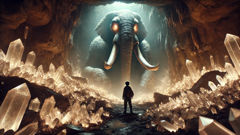
One of the earliest tales speaks of a young herder named //Gau, whose family had lost much in a harsh season. Hunger gnawed at their bones, and desperation led //Gau to wander farther from the kraal than any before him. He followed a trail of sparkling pebbles to the foot of a rocky outcrop, where a fissure yawned beneath ancient fig trees. Drawn by a strange compulsion, //Gau crept inside. At first, the air was cool and sweet, heavy with the scent of damp earth and something older—a metallic tang that stung his nostrils. Soon, he reached a cavernous chamber lit by the ghostly glow of phosphorescent crystals. Piles of gems tumbled across the floor like spilled grain, but at the center coiled the Grootslang itself.
Its eyes fixed on //Gau, unreadable and ageless. Fear rooted him to the spot as the beast raised its trunk, tasting his scent. But instead of striking, the Grootslang spoke—not with words, but with a rumble that shook //Gau’s heart. It asked why he had come. //Gau stammered about his family’s suffering. The Grootslang listened, its gaze searching his soul. Finally, it allowed him to take a single gem, warning that greed would bring ruin.
//Gau returned home, his fortune restored and his family saved. He became a respected elder, cautioning his descendants never to seek more than they needed. Some heeded the warning; others did not. Over time, stories spread of travelers who entered the cave in pursuit of endless riches. Some emerged empty-handed and changed, others vanished without a trace. The Grootslang’s legend grew, shaping the region’s customs: never boast of found treasures, never take more than you can carry, and always leave an offering for the unseen spirits of the land.
As outsiders arrived—colonists, prospectors, and adventurers—the tale spread beyond the mountains. For some, it became a challenge. For others, a mystery to solve. Yet all who journeyed into the Richtersveld’s depths felt the same weight: an awe that bordered on terror, and a sense that here, at the world’s edge, the ancient still lingered.
The Treasure Seekers: Bargains and Betrayal
The promise of unfathomable wealth drew more than humble herders to the Richtersveld. In the centuries that followed, fortune-seekers from distant lands crossed deserts and rivers to reach the fabled Wonder Hole. Some came with reverence; most came with greed. Their stories became woven into the legend of the Grootslang, shaping how it was remembered and feared.
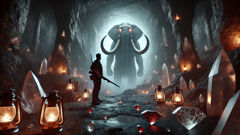
One such seeker was Jan van Niekerk, a diamond prospector from the Cape. Hardened by years of fruitless digging, Jan heard tales of a cave bursting with gems—treasure guarded by a beast that could be tricked with cunning or subdued with firepower. He arrived in the Richtersveld with a small band of men and enough dynamite to shatter a mountain. Locals warned him not to disturb what lay beneath, but Jan dismissed their fears as superstition.
After days of searching, Jan’s party found the cave entrance at twilight. The air grew heavy as they entered; lantern flames sputtered in sudden drafts. They pressed onward, deeper into the earth. The walls began to glitter, veins of quartz and diamond catching the light. Then a low rumble echoed through the darkness—a warning too late to heed. The Grootslang appeared in a swirl of shadow and dust, blocking the only exit.
Jan aimed his rifle and fired, but the bullets clinked off impenetrable scales. The Grootslang’s trunk lashed out, sweeping aside weapons and men alike. In desperation, Jan threw a satchel of dynamite at the beast’s feet and ran. The explosion shook the mountain, collapsing passages and burying Jan’s companions. Only Jan escaped, crawling into daylight with nothing but a single, fist-sized diamond clutched in his bloodied hand. The stone brought him no joy: he was haunted by nightmares, plagued by guilt and terror until his death.
Others tried subtler approaches. A cunning merchant once brought an offering of rare spices and fine silk, hoping to barter for safe passage. The Grootslang, amused, allowed her to leave unharmed with a handful of stones—but warned that such bargains could never be made twice. Another tale tells of a pair of thieves who tried to sneak into the cave at new moon. They vanished, leaving only their footprints in the dust.
Over time, the Grootslang’s reputation as a negotiator grew alongside its fearsome image. It was said that the creature understood every language and weighed every bargain with perfect fairness. Yet its patience had limits. Those who bargained in good faith sometimes left with their lives and a story to tell. Those who tried to cheat or overpower it were never seen again.
The stories shaped how people viewed wealth and wisdom. In the villages at the edge of the Richtersveld, parents taught their children that fortune must be earned honestly—and that sometimes, the greatest treasure was knowing when to walk away.
Conclusion
The legend of the Grootslang endures not just because of its fearsome presence or the lure of riches, but because it speaks to something elemental within us all—a tension between desire and restraint, ignorance and wisdom. In every generation, someone is tempted by tales of hidden treasure, by the promise that cunning or courage can outwit ancient forces. Yet the Grootslang’s story remains a reminder that some secrets are kept for a reason, and some boundaries are better respected than crossed. The Richtersveld still shimmers under the African sun, its stones whispering with echoes of old magic. The entrance to the Wonder Hole lies hidden among thickets and rocks, watched over by shadows and memory. Travelers who listen closely can hear the distant rumble of the Grootslang, neither vengeful nor cruel, but steadfast in its purpose: to guard what should not be easily claimed, to challenge those who would take without understanding. For those who seek wisdom over wealth, who respect the wild and accept that not every mystery is theirs to unravel, the Richtersveld offers a different kind of treasure—a sense of belonging to an ancient story, a glimpse into the world’s first dawn, and the knowledge that true riches are often hidden not in stone or gold, but in humility and awe.




